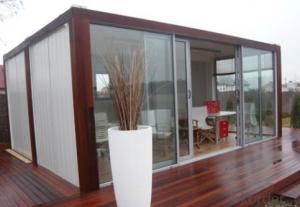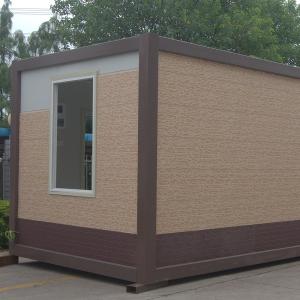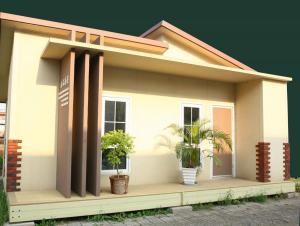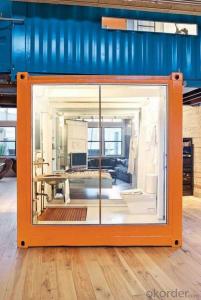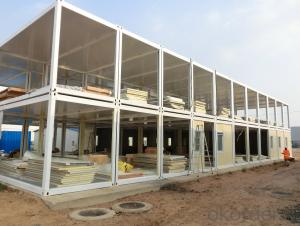Prefabricated shipping containers shops, cafes
OKorder Service Pledge
OKorder Financial Service
You Might Also Like
Specifications
1low cost modular house. low cost
2. easy installation
3 Green and environmental material
4. Power-Saved
Specifications
1. Firm structure and multiple use.
2. Lost cost and convenient in shippment.
CNBM INTERNATIONAL LOW COST PREBUILT CONTAINER HOUSES
Product description
1. Container house is a unit house with the size of 6055mm*2435mm*2740mm.
2. The container house adopts EPS, glass wool or rock wool as heat insulation material.
3. All the components are standard and prefabricated with the advantage of assembling and disassembling easily. Six skilled workers can finish three modular units in 8 hours.
4. 4sets of standard container house can be packed together to replace the shipping space of one 20ft container.
5. The container house can be linked freely at length, width and height through the linking kits for bigger structure and different layout.
6. Waterproof design of galvanized structure, fireproof and heat insulation of material ensure the house to resist heavy wind load of 0.6KN/m2and 8 degree seismic intensity.
7. The life span of the house is 20-25 years.
Characteristics
1. Cost Effectiveness
2. Chemical free, and lower waste
3. Easy to erect
4. Safety
5. Fireproof, termite free
6. Strong and durable – weatherproof, anti-seismic
7. Materials will not shrink, rot or warp
8. Pre-galvanized for rot and corrosion prevention
Benefits of factory built prefabricated houses and villas
| |
Very little maintenance | Reduce environmental pollution and save water |
Ease and speed of erection | Easily transportable |
Aesthetically pleasing | Buildings can be relocated |
Priced more economically than brick | Buildings can be designed by your choice
|
- Q:Do container houses require maintenance?
- Yes, container houses do require maintenance. Like any other type of house, container houses need regular upkeep to ensure their longevity and functionality. This may include routine inspections, cleaning, repainting, and repairs to the structure, insulation, plumbing, and electrical systems. Maintaining a container house is essential to prevent any potential issues and to keep it in good condition over time.
- Q:Are container houses suitable for recreational or sports facilities?
- Recreational or sports facilities can be well-suited for container houses. These structures possess numerous advantages that make them an appealing choice for this purpose. To begin with, container houses are incredibly versatile and easily customizable. They can be modified to meet specific requirements, enabling them to be transformed into gyms, swimming pools, yoga studios, or even sports team clubhouses. In addition, container houses are cost-effective in comparison to traditional construction methods. By utilizing repurposed shipping containers, the cost of materials is significantly reduced, making it a more affordable option. This cost-efficiency allows for more resources to be allocated towards equipment, maintenance, and other crucial aspects of the facility. Moreover, container houses are highly durable and capable of withstanding harsh weather conditions. Their steel structure provides stability and longevity, making them suitable for outdoor recreational or sports facilities. Furthermore, container houses can be easily transported and relocated, providing flexibility in terms of the facility's location. Lastly, container houses contribute to eco-friendliness. Repurposing shipping containers aids in waste reduction and material recycling, aligning with the construction industry's growing focus on sustainability. Although some modifications and customization may be necessary to cater specifically to recreational or sports needs, container houses offer a practical, cost-effective, durable, and eco-friendly solution for creating such facilities. Therefore, they are undoubtedly suitable options for recreational or sports facilities.
- Q:Can container houses be transported easily?
- Container houses have the advantage of being easily transportable. They are designed to be moved by trucks, trains, and ships, which makes relocating them simple. These houses are constructed to withstand rough handling during transportation and have corner castings that enable them to be lifted and stacked using cranes or forklifts. Furthermore, container houses can be effortlessly loaded and unloaded onto trailers or flatbed trucks, making them highly portable. This portability makes container houses an ideal option for temporary or mobile housing solutions, such as disaster relief, construction sites, or remote locations.
- Q:Can container houses be designed with a vintage or retro-inspired look?
- Certainly, container houses can be designed with a vintage or retro-inspired appearance. With a touch of creativity and thoughtful design choices, container houses can become one-of-a-kind and stylish homes that reflect a vintage or retro aesthetic. One approach to achieving a vintage or retro-inspired look in a container house involves the use of various materials and finishes. For instance, incorporating reclaimed wood or distressed metal accents can instantly create a rustic or industrial vibe reminiscent of past eras. Vintage-inspired wallpaper or tiles with retro patterns can also be utilized to establish a nostalgic atmosphere. Another crucial aspect in achieving a vintage or retro look is the selection of furniture and decorations. Opting for vintage or thrifted pieces can add character and charm to the space. Vintage-inspired lighting fixtures, curtains, and upholstery can also contribute to the overall retro ambiance. When it comes to the color palette, choosing muted or pastel shades that were popular in the past can enhance the vintage or retro look. Earthy tones, such as mustard yellow, olive green, or burnt orange, can evoke a 70s vibe, while pastel colors like mint green or powder blue can create a 50s or 60s aesthetic. Furthermore, architectural details play a significant role in achieving a vintage or retro-inspired look. Incorporating elements like exposed brick walls, arched doorways, or decorative moldings can add a touch of nostalgia. Additionally, selecting retro-inspired fixtures, such as clawfoot bathtubs or vintage-style faucets, can also contribute to the overall vintage feel. Ultimately, the key to designing container houses with a vintage or retro-inspired look lies in carefully selecting and combining different elements that evoke the desired aesthetic. By considering materials, furniture, colors, and architectural details, container houses can be transformed into unique homes that radiate a vintage or retro charm.
- Q:What are the concerns of container houses?
- Fire is the current construction site often happen, if you use the container activity room is a bubble color steel plate, then have to pay attention to fire.
- Q:What are the disadvantages of container houses?
- Before choosing a container house, potential homeowners should take into account several drawbacks associated with this type of dwelling. Firstly, the limited space in container houses can be a major disadvantage. Even though it is possible to combine multiple containers to create larger living spaces, the overall square footage is still relatively small compared to traditional homes. This can result in a cramped atmosphere and difficulties accommodating larger families or storing personal belongings. Another drawback is the potential for insulation issues. Containers are primarily constructed from steel, which conducts heat and cold more easily than other building materials. This means that container houses can be harder to heat or cool, leading to increased energy consumption and higher costs. Furthermore, the lack of insulation may leave the interior susceptible to extreme temperatures and noise pollution. In terms of design and customization, container homes face limitations. The rigid structure of containers may restrict the possibilities for creative architecture, making it challenging to create unique and aesthetically pleasing homes. Additionally, making structural modifications such as cutting windows or doors can be expensive and time-consuming. Furthermore, container houses may encounter difficulties with zoning and building codes. Certain areas have strict regulations that limit or forbid the use of container homes, making it challenging to find suitable locations for construction. Obtaining permits and meeting safety requirements can also be a complex process. Lastly, the resale value of container houses may be lower compared to traditional homes. The unconventional nature of container dwellings may narrow the potential market for interested buyers, making it more difficult to recover the initial investment. Overall, while container houses offer advantages such as affordability and sustainability, they also come with disadvantages related to limited space, insulation issues, design limitations, zoning challenges, and potentially lower resale value. It is crucial for individuals to carefully consider these drawbacks and weigh them against their needs and preferences before deciding if a container house is the right choice for them.
- Q:Are container houses suitable for areas with strict building codes?
- Yes, container houses can be suitable for areas with strict building codes. While they may require some modifications and additional permits to meet the specific requirements, container houses can still comply with building codes when built and designed properly. It is essential to work with experienced architects and contractors who are knowledgeable about local regulations to ensure compliance and obtain the necessary approvals.
- Q:Are container houses suitable for retirement living?
- Depending on one's preferences and needs, container houses can be a viable choice for retirement living. One major advantage of container houses is their affordability in comparison to traditional housing options. This is especially beneficial for retirees who have limited financial resources or are seeking to downsize and reduce expenses. Furthermore, container houses offer a high level of customization, allowing retirees to design a living space that caters to their specific requirements. They can be modified to include features such as easy accessibility ramps, wider doorways for mobility aids, and open floor plans to minimize excessive movement within the house. In addition, container houses are generally low-maintenance and energy-efficient. They are constructed using durable materials that require minimal upkeep, lessening the maintenance burden for retirees. Moreover, container houses can be equipped with eco-friendly features like solar panels and rainwater harvesting systems, which contribute to lower utility costs and reduced environmental impact. However, it's important to consider potential drawbacks of container houses for retirement living. Limited space might not be suitable for retirees who require more storage or dedicated areas for specific hobbies or interests. Additionally, container houses may not be situated in traditional retirement communities or neighborhoods, affecting the social aspect of retirement living for those who value community engagement and interaction. Ultimately, the suitability of container houses for retirement living hinges on the individual's preferences, financial situation, and specific needs. Retirees should thoroughly evaluate their requirements and explore all available options before making a decision. Seeking guidance from professionals in the field, such as architects or retirement living experts, can also provide valuable insights in determining the optimal housing solution for retirement.
- Q:Can container houses be designed with a home theater or media room?
- Certainly, container houses have the potential to include a home theater or media room in their design. These houses are highly adaptable and can be customized to cater to the specific requirements and preferences of the homeowner. By carefully considering the layout and employing appropriate planning and design strategies, it is possible to incorporate a dedicated area for a home theater or media room within a container house. This space can be tailored to accommodate essential equipment such as a large screen, surround sound system, comfortable seating, and storage for media devices. Additionally, container houses are renowned for their versatility, allowing for interior modifications and expansions based on individual preferences. Whether the goal is to create a separate room or integrate the media area within a larger space, container houses provide the flexibility needed to realize the homeowner's vision and adapt it to their lifestyle.
- Q:Can container houses be designed with a rainwater harvesting system?
- Yes, container houses can definitely be designed with a rainwater harvesting system. In fact, container houses are known for their adaptability and sustainability, making them an ideal choice for incorporating such eco-friendly systems. Rainwater harvesting systems collect and store rainwater that falls on the roof, which can then be used for various purposes such as irrigation, flushing toilets, or even for drinking water after proper treatment. These systems typically consist of gutters and downspouts to channel the rainwater into a storage tank or reservoir. When designing a container house with a rainwater harvesting system, several factors need to be considered. Firstly, the roof design should be optimized to efficiently collect rainwater, such as using sloping roofs or installing additional catchment areas. Secondly, the size of the storage tank should be determined based on the water demands of the house and the average rainfall in the area. Container houses offer great flexibility in terms of placement and customization. Therefore, the rainwater harvesting system can be integrated into the design from the beginning, ensuring seamless integration and optimal functionality. For example, the storage tank can be placed underneath the container house or adjacent to it, depending on the available space and structural considerations. It is important to note that proper filtration and purification systems should be installed to ensure the collected rainwater is safe for its intended use. Additionally, regular maintenance and cleaning of the system are crucial to prevent any contamination or blockages. Overall, container houses provide a great opportunity to incorporate rainwater harvesting systems, promoting sustainability and reducing reliance on traditional water sources. With proper design and implementation, container houses can effectively collect and utilize rainwater, contributing to a more eco-friendly and self-sufficient living environment.
1. Manufacturer Overview |
|
|---|---|
| Location | |
| Year Established | |
| Annual Output Value | |
| Main Markets | |
| Company Certifications | |
2. Manufacturer Certificates |
|
|---|---|
| a) Certification Name | |
| Range | |
| Reference | |
| Validity Period | |
3. Manufacturer Capability |
|
|---|---|
| a)Trade Capacity | |
| Nearest Port | |
| Export Percentage | |
| No.of Employees in Trade Department | |
| Language Spoken: | |
| b)Factory Information | |
| Factory Size: | |
| No. of Production Lines | |
| Contract Manufacturing | |
| Product Price Range | |
Send your message to us
Prefabricated shipping containers shops, cafes
OKorder Service Pledge
OKorder Financial Service
Similar products
New products
Hot products
Hot Searches
Related keywords
